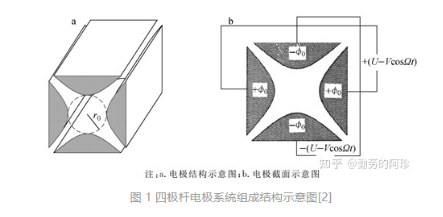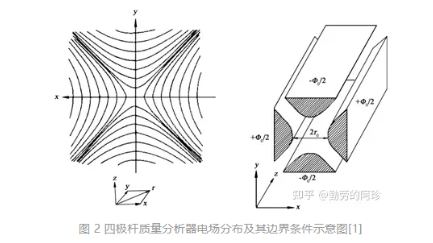1.Introduction to Quadrupole Mass Filters
Quadrupole mass spectrometry is one of the most mature and widely used compact mass spectrometers. In gas chromatography-mass spectrometry (GC/MS) and liquid chromatography-mass spectrometry (LC/MS) systems, the quadrupole mass filter is one of the most commonly used mass analyzers.
First, what is a mass analyzer? Mass spectrometry is an analytical technique that measures the mass-to-charge ratio (m/z) of ions. The basic principle is that sample components are ionized in an ion source to generate charged ions with different m/z ratios. These ions are accelerated by electric fields to form an ion beam that enters the mass analyzer. In the mass analyzer, electric and magnetic fields are utilized to induce velocity dispersion in opposite directions, focusing the ions and generating a mass spectrum. This allows determination of their masses.
The quadrupole mass filter is one of the most commonly used mass analyzers. Quadrupole mass spectrometers belong to the category of dynamic mass spectrometers. Since they utilize pure electric fields without involvement of magnetic fields, their structure is simple and lightweight. They only require the ion injection energy to be below a certain upper limit, and do not require energy focusing of the incoming ions. This allows coupling to simple, highly sensitive ion sources, and applicability to ions with a certain degree of energy dispersion, such as secondary ions. Their scanning speed is fast, and sensitivity and resolution can be adjusted by varying electrical parameters, allowing a single instrument to meet different analysis requirements. These advantages have made quadrupoles the subject of great interest since their inception, resulting in rapid development. Quadrupole mass spectrometry technology is now relatively mature. As a type of mass spectrometer with compact structure, full functionality, and low cost, it has found widespread use in fields including physics, analytical chemistry, medicine, environmental science, life sciences, and more.
2.Theory of the Quadrupole Electrode System
The theory of the quadrupole electrode system was established by Paul et al. in 1958. According to their assumptions and theoretical research, they proved that an ideal quadrupolar electric field distribution can be generated within a defined space by a quadrupole electrode system, but only when it consists of 4 geometrically identical electrodes with hyperbolic cross sections, arranged parallel and symmetrically around a central axis, as shown in Figure 1.

In actual use, the opposing pairs of the 4 electrodes are connected together, forming one pair of X electrodes and one pair of Y electrodes. The quadrupole is powered by a radio frequency (RF) power supply that contains both a high frequency alternating current voltage and a direct current voltage component. When the positive and negative RF power supply outputs are applied to the X and Y electrode pairs respectively, this generates a quadrupolar electric field distribution within the space enclosed by the quadrupole electrodes. The motion of ions within this time-dependent quadrupolar field is the basis for ion confinement and mass analysis in the quadrupole mass filter. The electric field distribution in the quadrupole is shown in Figure 2.

3.Quadrupoles in Practical Quadrupole Mass Spectrometers
The field distribution in a quadrupole mass analyzer is an ideal hyperbolic field obtained through ideal hyperbolic electrodes. In practice, machining and assembly of ideal hyperbolic rods is quite challenging, so circular rods are commonly used in quadrupole mass spectrometers instead of hyperbolic electrodes. The quadrupole radius is adjusted to make the actual field distribution as close as possible to the ideal hyperbolic field. Figure 3 shows a schematic of a practical quadrupole mass analyzer. Since circular rods are used instead of hyperbolic electrodes, the actual resolution of quadrupole mass spectrometers is still largely limited by factors like machining, assembly, and fringe fields of the circular quadrupole.

4.Tandem Quadrupoles
In research applications, quadrupole mass spectrometers are often used in multi-stage tandem MS systems, where quadrupoles are one of the most common mass analyzer types. The most common tandem MS system is a triple quadrupole with three quadrupole mass analyzers arranged in a QqQ configuration, as shown in Figure 4.

Here, Q1 and Q3 are conventional mass analyzers, while q2 has no DC voltage and only the RF component. The RF-only field in q2 focuses all ions and allows them to pass through. Thus, q2 acts like a field-free region in a magnetic sector mass spectrometer, where ions can undergo metastable fragmentation or collision-induced dissociation (CID). Q1 can select ions of interest from the ion source, induce fragmentation in q2, and deliver the fragment ions to Q3 for conventional mass analysis to deduce the molecular structure. More complex systems can use 5 quadrupoles in a QqQqQ configuration for MS/MS/MS experiments with 3 mass analyzers and 2 reaction cells. In theory up to 10 quadrupoles can be tandemly arranged, but in practice, triple quadrupoles are the most commonly used tandem mass spectrometry systems. QqQ instruments can also readily change the kinetic energy of ions. When ions collide with the collision gas at different kinetic energies, different amounts of thermodynamic energy are deposited, enabling energy-resolved CID experiments to elucidate fragmentation mechanisms. Although quadrupole mass analyzers cannot perform high resolution measurements, unit mass resolution is readily achieved. In practice, QqQ instruments can produce MS/MS spectra with better resolution than double-focusing BE instruments.
Retrievedfrom Knowing Hardworking Precious,Original link:https://zhuanlan.zhihu.com/p/371723146